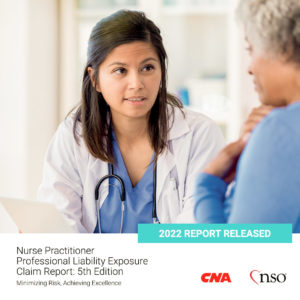Nurse practitioners (NPs) have a great deal of responsibility regarding patient care, and as the healthcare landscape evolves, so do the daily risks NPs face. Despite compassionate work and service to the community, one lawsuit can affect your professional reputation. Nurse practitioner malpractice data can be used to inform and address areas of clinical improvement as well as help to improve the quality of care and patient safety.
Nurses Service Organization (NSO) and CNA have published the new edition of the Nurse Practitioner Professional Liability Exposure Claim Report analyzing 232 closed professional liability claims against NPs, student NPs, and NPs covered through a CNA-insured healthcare business over five years (2017-2021). By equipping NPs with data, resources, and case study examples, our goal is to help them recognize their exposures, reduce their risks, and improve patient outcomes.
Here are the key takeaways.
NP Professional Liability 5-Year Closed Claim Analysis Patterns and Trends
Malpractice claim costs are on the rise.
The average total incurred amount of a nurse practitioner malpractice claim has increased to $332,137 – a jump of more than 10.5% since 2017. In addition, there has been a continued shift towards larger claim settlements. For example, claims resolved for greater than $500,000 represented 21.5% of all claims in the 2022 dataset, compared to 13% in the 2012 dataset.
The most common allegation against NPs is related to diagnosis.
Diagnosis-related allegations represented 37.1% of all allegations against nurse practitioners and continue to be the leading allegation through 2012, 2017, and 2022 datasets. Contributing factors for these diagnosis-related claims included the failure of an NP to order a diagnostic/lab test to establish a diagnosis, failure to obtain a complete history and physical of the patient, and failure to refer a patient to higher level care.
Cancer and infection are the two most common diagnosis-related injuries, representing more than half of the claims. In many diagnosis-related closed claims, a lack of sound documentation supporting the decision-making process of the treating NP or other staff members under the NP’s supervision hindered the case’s legal defense.
Common missing or incomplete documentation noted in the dataset included:
- Lack of a complete patient and family history.
- Incomplete physical assessment.
- Failure to list current medications and/or complaints.
- Failure to document patient noncompliance with appointments, ordered diagnostic tests and/or prescribed medications.
- Absence of notification of diagnostic test results and recommendations for further treatment or testing.
Nurse Practitioner’s Failure and Outcome
An example of an NP’s failure to order diagnostic/laboratory testing includes:
A 51-year-old diabetic male patient presented to the NP’s office following an emergency department (ED) visit due to a wound on his right foot that appeared to be infected. The NP photographed the wound, documented that it was 0.5 cm in diameter, and confirmed that the patient was still taking the antibiotics as prescribed to him by the ED provider.
Although he was instructed to return in a week for a recheck, he presented two weeks later. The NP documented the wound as 2 cm in diameter with granulation tissue and purulent drainage, and the forefoot was reddened, warm, and swollen. The NP opined that he might need to perform a procedure to evacuate the infected area, but for unknown reasons, the procedure was not performed. Instead, the patient was given a prescription for a different antibiotic, and his wound was cleaned and redressed. One week later, the patient returned, reporting vomiting and feeling weak. His eyes were jaundiced, and his right toe and right leg were more swollen than the prior week. The NP ordered Ceftriaxone 1 gram intramuscularly in the office and then every 24 hours for the next three days via home health. Also ordered were daily dressing changes to the affected foot, vital signs, and bi-weekly (twice-a-week) blood work for the next two weeks.
When home health arrived for the initial visit at the patient’s home, he appeared diaphoretic and pale. His vital signs were indicative of sepsis (high fever, elevated heart, respiratory rate, and low blood pressure). The patient was transferred to the ED and diagnosed with sepsis. He eventually underwent a below-the-knee amputation of his right leg.
Defense experts could not defend the claim, as they indicated that the patient should have been sent to the ED during his last visit with the NP or referred to an infectious specialist or wound care provider after his second visit. The NP testified he had encouraged the patient to go to the ED for treatment on the second and third visits but that the patient refused. There was no documentation in the patient’s healthcare information record to corroborate this testimony. The claim was resolved with a total incurred of greater than $950,000.
Nurse Practitioners: Analysis of License Protection Paid Claims
State Board of Nursing (SBON) investigations are serious matters and a significant investment of time and effort by the NP until they are resolved. Therefore, legal representation in these matters is highly recommended. A complaint against an NP’s license to an SBON differs from a professional liability claim in that it may or may not involve allegations of patient care and treatment provided by an NP. The disciplinary matters in this section represent the cost of providing legal representation to an NP in defending such actions rather than indemnity or settlement payments to a plaintiff.
The cost to defend license matters is increasing. For example, the average cost of defending complaints against nurse practitioners to an SBON is $7,155, a 19.5% increase compared to the 2017 report and a 61.1% increase compared to the 2012 report.
Key findings in the 2022 dataset related to licensing board complaints are:
- Professional conduct, medication prescribing, and scope of practice complaints account for more than half of all license protection closed matters (58.4%).
- License board complaints related to the professional conduct category were largely driven by matters categorized as professional misconduct defined by the state, such as unprofessional conduct with patients or coworkers, termination from employment due to unspecified performance issues, and professional boundary issues with patients.
- Approximately 43% of license board protection matters led to some board action against an NP’s license. Common SBON actions included probation (12%), public reprimand (11.2%), consent order or stipulation (6.4%), and a fine (3.6%). The more severe SBON decisions – such as the surrender of license (2%), revocation (2.4%), and suspension (2.8%) – are less common but can effectively end an NP’s career.
Risk Control Recommendations for Nurse Practitioners
The following risk control recommendations can serve as a starting point for nurse practitioners seeking to evaluate and enhance their patient safety and risk management practices:
- Practice within the requirements of your state nurse practice act, in compliance with organizational policies and procedures, and within the national standard of care.
- Maintain basic clinical and specialty competencies by proactively obtaining the professional information, education, and training needed to remain current regarding nursing techniques, clinical practice, medications, biologics, and equipment.
- Document your patient care assessments, observations, communications, and actions in an objective, timely, accurate, complete, and appropriate manner.
- Consider these questions when pursuing a specific diagnosis:
- Are factors present that do not align with the diagnosis?
- Are there symptoms inconsistent with the current diagnosis?
- Are the symptoms indicative of another diagnosis?
- Are there elements that can’t be explained?
- Is there a condition with similar symptoms to consider?
In Summary
This analysis of NP professional liability and license protection closed claims reveals that, while there have been advances in clinical practice and patient safety, many claims continue to develop due to a failure to diagnose, treat, or take precautions regarding medication safety. Further, communication missteps, inadequate documentation, and unprofessional conduct made matters challenging to defend.
It is anticipated that the data, analysis, and risk control recommendations shared in the report will inspire nurse practitioners nationwide to examine their practices and focus their risk control efforts on the areas of statistically demonstrated error and loss.
The Nurse Practitioner Professional Liability Exposure Claim Report: 5th Edition is the fifth claim report published by CNA and NSO addressing nurse practitioner liability since 2005 and represents NSO and CNA’s ongoing commitment to educating the nursing community. The general analysis includes 232 anonymized closed claims involving a nurse practitioner, nurse practitioner receiving coverage through a CNA-insured healthcare business, or nurse practitioner student that resulted in paid indemnity greater than or equal to $10,000.
Download the complete report here.
This information is provided for general informational purposes and does not provide individual guidance. This information is not a substitute for any workplace practices and is not establishing a standard of care.
- Risks Facing Nurse Practitioners Today - November 14, 2022
- Understanding Professional Liability Risks of Record Management - March 23, 2018
- Informed Consent and Informed Refusal in Managing Patient Expectations - March 15, 2018




